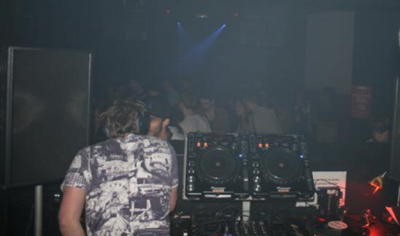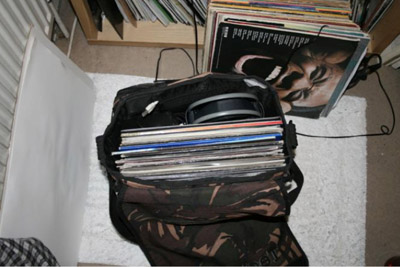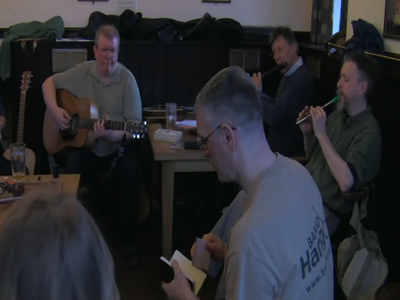Authors: Steve Benford
Posted: Mon, November 04, 2013 - 10:43:07
If I hadn’t been a banjo player then perhaps I might have been a DJ. After all, both are cool, hip, and generally down with the kids. There are other similarities, too, as my colleagues Yousif Ahmed and Andy Crabtree have revealed through an ethnographic study of the lives of nightclub DJs.
When I think of a DJ, I immediately picture someone spinning discs on a turntable in a nightclub. Our study revealed that there is far more to the matter than this. First, there is the all-important task of building a music collection. A DJ’s reputation is made through the music they play, making it a pressing and ongoing concern to acquire new music that sets them apart and lends them a distinctive identity. This may involve “crate digging,” scouring record shops for second-hand vinyl that contains rare or unusual tracks that can be rediscovered and repurposed. It also often involves producing their own music, or even being given music by others that they want promoted. Either way, an active DJ is likely to be constantly on the lookout for distinctive new music to enhance their collection and reputation.

A DJ performing
Crates and improvisation
Where this music is on vinyl—and it is clear that many DJs still value vinyl for its sound quality, tangibility, and also rarity—then it soon becomes impossible for a DJ to take their entire music collection to a gig. This necessitates the tricky business of choosing in advance a just part of the collection that is small enough to be loaded into a “crate” ready for transportation to the gig. Traditionally, this would be a beer or milk crate, hence the name, but it might just as well be a gig bag or even an electronic folder within dedicated DJ software on their laptop. This last point is particularly intriguing. Surely modern DJs can easily take an enormous music collection to a gig on their laptop. So why assemble a crate? And yes, they still do this. And yes, these folders of digital tracks are still called crates.

A DJ’s crate
We think that answer lies in the nature of improvisation. There is an important element of improvisation to a DJs performance as they select and segue different tracks by beat-matching and choosing the next track in response to the crowd or the way the evening is unfolding. While choosing the next track involves an element of improvisation, this is not completely unconstrained. In the heat of the moment, in a dark nightclub, it is important to be able to quickly pick a track that is going to fit into the set, and this is where the crate comes in. The crate contains a preselection of music, carefully chosen to fit this particular gig, venue, likely crowd, and also with an awareness of other DJs on the bill (it is, for example, good etiquette not to steal the thunder of later DJs by driving the crowd into a frenzy too early on). The tracks in the crate—be they records in a box or bag, or files in a digital crate—may also be prearranged into a rough order in which they are likely to be played. Consequently, the crate provides something of a safety net for improvisation. The DJ can experiment with selecting tracks knowing that whatever they choose is generally likely to fit and can fall back to the predetermined sequence when things get hairy.
So why are DJs like banjo players?
At this point I’m experiencing a distinct case of deja vu. A few months back I was writing about my other life as an amateur banjo player at Irish music sessions. There are some striking similarities between Irish-style banjo playing and the activities of DJs, other than the innate coolness that I’ve already mentioned. First, both forms of music involve sequencing tracks or tunes together. The art of the DJ is to sequence different tracks together, while that that of the Irish musician is to sequence several traditional tunes into a set. This sequencing is a creative act and an important opportunity for improvisation in both forms of music. Moreover, just as the DJ relies on having a preassembled crate of records to work from, so the Irish musician may have preselected and rehearsed sets of tunes drawn from their wider repertoire. These tunes are the equivalent of the DJ’s “crate,” a small working set of music that is immediately available “at their fingers” and that has been tailored to a particular event. These sets are often written down in a notebook.

A Banjo player discretely checks his crate
Situated discretion revisited
There is another striking similarity between the musical practices of DJs and those of Irish session musicians that we refer to as situated discretion. We saw previously how Irish musicians are cautious about revealing evidence of their preparations during a live session, designing their notebooks to be suitably discrete so as to fit in with the prevailing etiquette of playing by ear. Yousif’s study has revealed that DJs employ their own version of situated discretion in which they also adapt the presentation of their crates to be appropriately discrete. This involves changing information to deliberately hide, or sometimes reveal, the contents of their crates to other DJs or audience members. DJs who have invested great effort in digging up rare vinyl may even go as far as to paste white labels over the centers of records or change the names of tracks in their digital crates so as to disguise them. As one of Yousif’s participants described:
There’s an element of secrecy there, which is what they used to do in the old days as well. All the hip-hop guys and stuff, when hip-hop was quite big, like Afrika Bambaata and stuff, used to put white stickers all over the centre of their records so no-one could come up and read them and see what it was. It’s trying to keep the tunes, like, exciting. You wanna build a hype around them.
On the other hand, if they have been given a track to promote they may go out of their way to make this musical metadata available to others. In other words, DJs carefully design the presentation of their crates to be appropriately discrete with respect to a given performance situation.
On the nature of improvisation
Given that we see such striking similarities between two very different musical practices, it is tempting to think that notions of crates, working sets, and situated discretion may have a wider relevance to improvisation. Might we see their equivalents within other improvised practices—perhaps in jazz or rock music, comedy, or even at work? To what extent does the art of improvisation rely on the careful selection, preparation, and rehearsal of material so that it is ready to hand and can easily be brought into a live situation, but in a suitably discrete and situated way so as to respect its form and local etiquette? And what new technologies can enable people to assemble and use their various “crates” when improvising?
Posted in: on Mon, November 04, 2013 - 10:43:07
Steve Benford
View All Steve Benford's Posts






Post Comment
No Comments Found